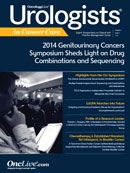Publication
Article
Oncology Live Urologists in Cancer Care®
Hospital Admissions and Rectal Procedures are More Common After Radiotherapy Than Prostatectomy
Author(s):
Men with clinically localized prostate cancer who were treated with radiotherapy were more likely, over the subsequent 5 years, to be admitted to a hospital, undergo rectal, anal, or open surgical procedures, or develop secondary malignancies than men treated with radical prostatectomy
Robert Nam, MD, MSc, FRCS(C)
Men with clinically localized prostate cancer who were treated with radiotherapy were more likely, over the subsequent 5 years, to be admitted to a hospital, undergo rectal, anal, or open surgical procedures, or develop secondary malignancies than men treated with radical prostatectomy, although those in the surgery group faced a higher risk for urological procedures, according to the results of a study published recently in the British Journal of Anaesthesia. Nam et al conducted the study as a means of helping these patients and their physicians to choose treatment options, since it is not yet clear whether survival is better with radiotherapy versus prostatectomy, and decisions are often made based on patient preference. “Patients want to know the frequencies and severities of various complications associated with different treatments,” the authors wrote.
The investigators did not look at the incidence of urinary incontinence or erectile dysfunction, saying that these potential side effects of surgery or radiotherapy have been the focus of many studies in the past. Instead, they considered complications including post-treatment urinary or rectal bleeding; infection in the urinary or lower gastrointestinal tract; recto-urethral fistulae; an increased prevalence of secondary malignancies; and other complications treated on an outpatient basis that might necessitate minimally invasive urological procedures (eg, cystoscopy) or other endoscopic procedures (eg, colonoscopy). Their study, they said, was the first to comprehensively assess these endpoints after radical prostatectomy or radiotherapy.
“Accurate knowledge of the incidence of such complications would enhance patient-centered decision making,” they wrote. In the population-based, retrospective cohort study, the authors included all men aged 18 years and older who underwent a radical prostatectomy or had radiotherapy for localized prostate cancer between January1, 2002, and December 31, 2009, in Ontario. They excluded patients who underwent laparoscopic or robotic prostatectomy, since the procedure was not routinely used in Ontario during the study period, and also those who underwent both radiation treatment and radical prostatectomy. A total of 3265 men, found in the records of Ontario’s government-operated healthcare system, were included in the study. Of these patients, 1570 underwent radical prostatectomy and 1695 had radiotherapy. The authors also identified a control group with no history of prostate cancer for comparison.
The study’s endpoints were the 5-year cumulative incidence of hospital admissions; urological, rectal, or anal procedures; open surgical procedures; and secondary malignancies.
The authors found that patients given radiotherapy had a higher incidence of hospital admissions, rectal or anal procedures, open surgical procedures, and secondary malignancies at 5 years than did those who underwent surgery (adjusted hazard ratios [HRs] 2.08—10.8, P <.0001). However, the number of urological procedures was lower in the radiotherapy than in the surgery group (adjusted hazard ratio 0.66, 95% CI 0.63—0.69; P <.0001).
The investigators also looked at a subgroup of men in the targeted population who were admitted to the hospital and stayed more than 1 night, finding that was more likely in patients who had undergone radiotherapy (3.3%, 95% CI, 3.0—3.6) as opposed to surgery (1.5%, 1.3–1.7; P <.0001). The adjusted HR for hospital admission of longer than 1 day for patients who had radiotherapy compared with those who had surgery was 5.55 (95% CI, 3.55— 8.67, P <.0001).
Most of the hospital admissions in the surgical group were for urinary obstruction, whereas hospital admissions in the radiotherapy group were largely due to radiation proctitis, the authors wrote. Open surgical procedures were the least frequent of all adverse outcomes, they noted.
In assessing the development of second malignancies from 5 to 9 years after treatment, the authors found a risk of 113 per 100,000 person-years in the surgery group and 309 per 100,000 person-years in the radiotherapy group. The cumulative incidence in years 5 to 9 was 4.5% in the radiotherapy group and 1.8% in the surgery group. The most common site of secondary malignancy was the gastrointestinal tract, and increased risk was also reported for lung, hematological, and genitourinary cancers. To establish whether the development of such cancers was associated with treatment, the authors compared results with the cancer incidence in the general population.
“Increasing age and comorbidity were associated with higher incidence of complications, but the type of treatment was the most important determinant,” the authors concluded. “Patients and physicians should be aware of these risks when choosing treatment for prostate cancer, and should balance them with the clinical effectiveness of each therapy.”
Reference
Nam RK, Cheung P, Herschorn S, et al. Incidence of complications other than urinary incontinence or erectile dysfunction after radical prostatectomy or radio-therapy for prostate cancer: a population-based cohort study. Lancet. Published online ahead of print, January 17, 2014.










